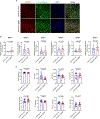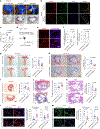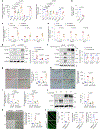Endothelial IGFBP6 suppresses vascular inflammation and atherosclerosis
- PMID: 39794479
- PMCID: PMC11825279
- DOI: 10.1038/s44161-024-00591-0
Endothelial IGFBP6 suppresses vascular inflammation and atherosclerosis
Abstract
Beyond dyslipidemia, inflammation contributes to the development of atherosclerosis. However, intrinsic factors that counteract vascular inflammation and atherosclerosis remain scarce. Here we identify insulin-like growth factor binding protein 6 (IGFBP6) as a homeostasis-associated molecule that restrains endothelial inflammation and atherosclerosis. IGFBP6 levels are significantly reduced in human atherosclerotic arteries and patient serum. Reduction of IGFBP6 in human endothelial cells by siRNA increases inflammatory molecule expression and monocyte adhesion. Conversely, pro-inflammatory effects mediated by disturbed flow (DF) and tumor necrosis factor (TNF) are reversed by IGFBP6 overexpression. Mechanistic investigations further reveal that IGFBP6 executes anti-inflammatory effects directly through the major vault protein (MVP)-c-Jun N-terminal kinase (JNK)/nuclear factor kappa B (NF-κB) signaling axis. Finally, IGFBP6-deficient mice show aggravated diet- and DF-induced atherosclerosis, whereas endothelial-cell-specific IGFBP6-overexpressing mice protect against atherosclerosis. Based on these findings, we propose that reduction of endothelial IGFBP6 is a predisposing factor in vascular inflammation and atherosclerosis, which can be therapeutically targeted.
© 2025. The Author(s), under exclusive licence to Springer Nature Limited.
Conflict of interest statement
Competing interests: The authors declare no competing interests.
Figures

















References
-
- Libby P et al. Atherosclerosis. Nat. Rev. Dis. Primers 5, 56 (2019). - PubMed
-
- Souilhol C et al. Endothelial responses to shear stress in atherosclerosis: a novel role for developmental genes. Nat. Rev. Cardiol. 17, 52–63 (2020). - PubMed
-
- Davies PF Endothelial mechanisms of flow-mediated athero-protection and susceptibility. Circ. Res. 101, 10–12 (2007). - PubMed
MeSH terms
Substances
Grants and funding
LinkOut - more resources
Full Text Sources
Medical
Research Materials
Miscellaneous
